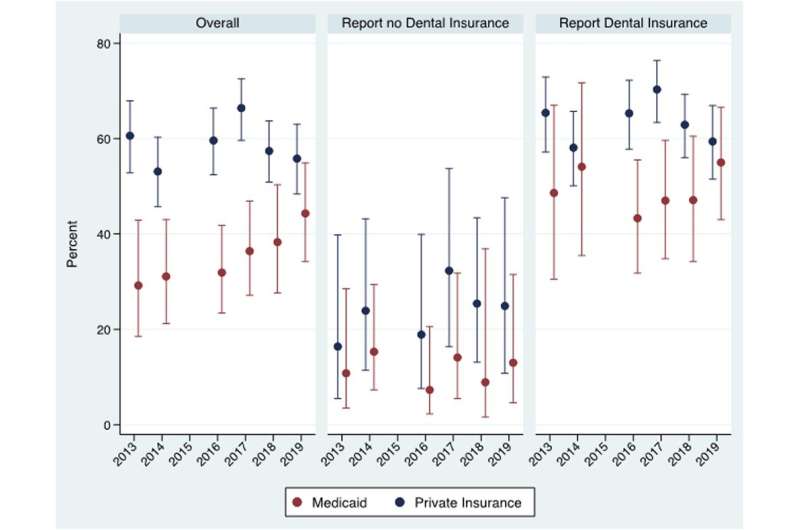This article has been reviewed according to Science X's editorial process and policies. Editors have highlighted the following attributes while ensuring the content's credibility:
fact-checked
trusted source
proofread
Study measures impact of Medicaid dental coverage for Virginia's pregnant population

When pregnant, taking care of your health is more important than ever. This also includes your oral health. Because of various changes happening in your body, like hormones and eating habits, pregnancy is often a period of higher risk for gum disease, cavities and other oral health problems. Oral issues that arise during pregnancy have been associated with serious health consequences for the mother and baby, including premature birth, low birth weight and pre-eclampsia.
Despite the importance of oral health during this period, a significant number of women end up never seeing a dentist while pregnant, with lack of dental insurance being a major obstacle for low-income women.
In 2015, Virginia began providing comprehensive dental benefits to pregnant Medicaid enrollees in an effort to eliminate a key barrier to dental care access. In the first study of its kind, researchers from the VCU School of Dentistry and VCU School of Business analyzed survey data to shed light on the policy's impact on pregnant women.
They found that expanding dental benefits helped reduce dental care disparities for Virginia's pregnant population over time. However, the researchers say continued work is needed to increase awareness of the benefit and remove other barriers to oral health.
"Providing dental benefits through Medicaid plays a big part in making dental care more affordable, but, until this study, we didn't really know how or when the policy would impact pregnant Medicaid enrollees," said Shillpa Naavaal, B.D.S., M.S., M.P.H., an associate professor in the Department of Dental Public Health and Policy at the School of Dentistry and lead author of the study.
Naavaal worked with David Harless, Ph.D., an economics professor at the School of Business, to analyze data from the Virginia Pregnancy Risk Assessment Monitoring System, a survey designed to capture women's experiences during pregnancy. They specifically examined data from the years immediately before (2013–2014) and after (2016–2019) Virginia's policy change.
Their results revealed that the percentage of Medicaid-enrolled pregnant women who self-reported having dental insurance jumped from 44.4% to 71.6% in the four years following policy implementation. While this increase is an encouraging sign, Naavaal says it also means some pregnant women don't realize they have dental benefits through Medicaid.
"As of 2015, 100% of pregnant women enrolled in Medicaid have dental insurance, however our study shows that, even four years later, 20–30% of women aren't aware that this is the case," she said. "This shows us that you can have the best policy, but if people aren't aware of the benefits that policy provides there will still be a gap to fill, and the time to get policy returns may be longer."
Additionally, the researchers examined how often pregnant Medicaid enrollees took advantage of their dental insurance for routine visits or preventative care, such as getting their teeth cleaned. They found that the percentage of Medicaid-enrolled women receiving dental services grew from 30.3% to 44.3% by 2019, four years after the policy went into effect.
"Although reports of dental insurance spiked following the policy change, there wasn't a significant increase in dental care utilization in the first two years. However, we did start to see some momentum by 2018," Naavaal said. "This shows that policy effects are not instantaneous and can take a few years to show impact."
The gap in dental care usage between Medicaid-enrolled and privately insured women narrowed over the years as well. In 2019, the increase in dental care use was 17 percentage points higher among Medicaid-enrolled women compared to women with private insurance.
The findings also suggests that additional barriers are still preventing low-income women from getting dental services while pregnant. For example, it's possible that some women weren't able to schedule time for an appointment within their window of eligibility or were unable to find a provider nearby who accepts Medicaid patients.
"Even though our research was specific to Virginia, there are several states that already have or are considering adopting similar policies for their Medicaid program," Naavaal said. "It's very encouraging to see the positive impact of Medicaid in increasing dental care access and use and reducing disparities among pregnant women. Through this work, we've provided a deeper understanding on Medicaid's role in supporting oral health and the work that needs to be done to sustain it."
More information: Shillpa Naavaal et al, Comprehensive pregnancy dental benefits improved dental coverage and increased dental care utilization among Medicaid-enrolled pregnant women in Virginia, Frontiers in Oral Health (2022). DOI: 10.3389/froh.2022.989659


















